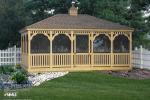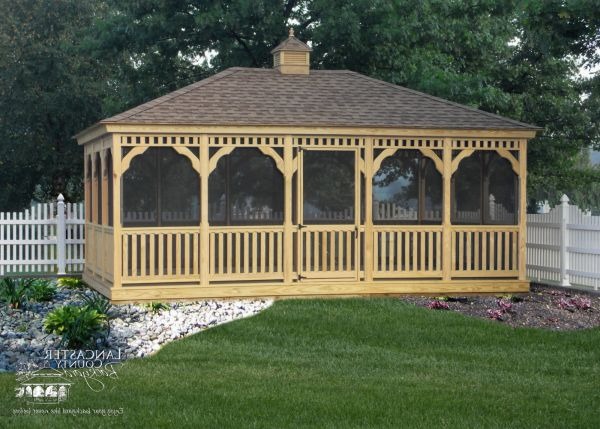Drafts To Assemble Square Pergola : Unearth Useful Secrets To Construct A Summerhouse


For a roof that must shed water, the rafters are sloped. The last row of planks might need a trim to ensure they fit snuggly against the hub at the apex of the gazebo. Pre-drill two holes through the side beams and supports for carriage bolts. Once the gazebo pieces are all cut, it is time to assemble. Pergolas and patio covers let you spend time in your landscape even on the most sweltering of summer days. In just a couple of weekends, you could be the owner of (https://www.squaregazeboplans.com) an exciting new place to spend time with the children on those hot summer days.
The type of lumber is not important either, as this template will be discarded once the columns have been concreted into the ground. It may take some adjusting, a little extra cutting of the slot and some hammering to get the 2 x 6 in place. Do this for both opposing faces of the support to establish the cut lines for the tenon. Level the gravel and tamp it smooth. Knock out the waste with your hammer, and clean up any remaining chunks with a wood chisel. Use at least 2 bolts for each joint. Next fill down to the rafter tails, again ripping the final board to width if necessary.
That's how to build a pavilion attached to the house. Place these slats equally spaced for (see) a professional result. Tighten it up as much as you can. At this point, you can remove the 2-by-4 braces from the posts. When everything was put together, we relaxed and celebrated a job well done. You could skip this step if you prefer the flush ends. Use construction adhesive formulated for concrete block to secure the cap and corner blocks. Hanging chairs can put a significant amount of stress on the various components, both in the weight they carry and in the torsional stress they put on the structure.
Use batter planks and string to make sure the diagonals are equal. As for diagonal bracing, in general a 45 degree brace is stronger than a brace with a steeper angle, and a longer brace is better than a shorter brace. This would ensure the rest of the project would be square to the posts. Then make the cuts, clamp them all together, and coat the ends and skinny sides. Every support is fixed to the structure with screws. This first part acts as an overview of the process with detailed instructions for planning and layout. Use a hatchet or an axe to create flat planes for joinery.
In addition, you can adjust the height of the balusters, according to your needs and tastes. The quickest, easiest way to drill into concrete is with a hammer drill, which uses both bit rotation and concussive blows to bore the holes. How to build a patio on a summerhouse Last but not least, we recommend you to take care of the finishing touches. This type of wood is hard, thick and heavy making it most ideal to use with slate or stone surfaces. We cut the corners of the 2 x 8 at a 45 degree angle to make it a little more decorative.
The plans used are freely downloadable trough the instructable. Make angle cuts to the corners, as shown in the diagram. Drill the holes for the bases and slide them into position. If it's just a smaller pergola, you could take most gazebo plans and just scale them down. The above pavilion design is a little different than most. Install the center support for the deck. Use a bar level to ensure the lines are vertical. Most shops have a shear that easily cuts the steel angle. If you prefer, you can replace these beam and column braces with something more decorative.
It provides a peaceful atmosphere for you and your family to enjoy. Now, this isn't a small Summer house by any means. Fill the concrete tube form all the way to its top with wet concrete. That will allow people to come and go freely without having to cut through the main interior space. Finally, fix each crossbeam in place using screws and if preferred, you could countersink your screw holes for a clean aesthetic. Or, you could choose a retractable option that allow you to use the screens when necessary. That is, providing, the base layer is square right from the start.
Use a wrench to tighten the lag screws. It's also a good idea to have a contract, specifying details like how connections are to be made, depth of footers, size and spacing of headers and joists, etc.